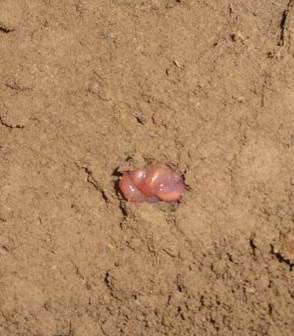Earthworms are a welcomed sight in many gardens and yards since they can improve soil structure and mixing. But they are hard to find in the drier soils of eastern Colorado where water and organic matter is limited. Adding earthworms to fields where they are not currently found could help enhance the health and productivity of the soil. In areas where droughts are common, though, can earthworms survive? A new study suggests that they can.

Earthworms use water for many things – for respiration, to keep their bodies from drying out, and to make the mucus that helps them slide through the soil. When soils get dry, earthworms go into estivation.
“During estivation, earthworms wrap their bodies into a tight knot to reduce the amount of surface area exposed to the soil,” explains Jacob McDaniel, lead author of the study published today in the September-October issue of Soil Science Society of America Journal. “Then they’ll seal themselves up in a chamber lined with their mucus. Inside that chamber, the humidity is higher so they don’t dry out as the soil dries.”
The ability of earthworms to go into estivation suggests they can survive dry periods in the soil. The aim of the current study was to find out how long they could survive and whether they would recover after an extended drought. To answer those questions, researchers from Colorado State University recreated drought conditions in pots containing soil and worms.
Earthworms live in Colorado soils, but their distribution is limited. They are mostly found in areas close to water or with higher levels of precipitation or irrigation. Earthworms for the current study were gathered near an irrigated alfalfa field close to Fort Collins. If these worms can survive periods of drought, they could be established in no-till, dryland agricultural soils of eastern Colorado to improve and mix soils.
Four different levels of drought stress were created for the study: constant water and one, two, or three weeks without added water. These conditions were based on rainfall patterns in the area where the soil for the study – a sandy loam from a dryland agricultural field – was collected.
Before the start of the study, the earthworms were gathered, allowed to acclimate to the soil for four days, and weighed. Each pot containing the soil and earthworms was then watered. Pots were again watered at the end of each one-, two-, or three-week drought period. At 21, 42, and 63 days, the earthworms were found within the soil and classified as active, in estivation, or dead. The alive and estivating earthworms were then rewetted and weighed.
McDaniel and his co-authors found that the length of drought stress affected the number of earthworms that died or went into estivation. More earthworms went into estivation as the drought stress period got longer. Fourteen percent of earthworms died in the three-week drought, significantly more than in the other treatments. Still, the earthworms that survived drought, even for three weeks, were able to recover after rewetting.
“If the soil did get rewetted, their weight didn’t change,” says McDaniel. “They should be able to survive through and recover after a drought that matches our conditions.”
The results of the study suggest that by going into estivation, earthworms could survive in drought-prone soils, such as those in eastern Colorado. But further work will be done to pinpoint strategies to increase their survival and understand their drought response. McDaniel explains that an important step will be to see what happens out in a field.
“The stress in the pots could be very different than what we would see in the field,” he says. “Future work needs to be done in the field setting with actual droughts instead of set time periods.”
Also, researchers want to find out whether the amount of time earthworms are allowed to acclimate to soils before encountering drought stress affects their survival. If an ideal length of time for acclimation can be found, efforts to establish earthworms may be more successful. Then even drought-prone, dryland soils could reap the benefits that worms provide to other soils throughout the world.
For more information, contact Jacob McDaniel at jacob.mcdaniel@colostate.edu.
'庫間 > 해외자료' 카테고리의 다른 글
| 유전자변형 BT 옥수수에 내성이 생긴 해충들 (0) | 2013.09.22 |
|---|---|
| 농약이 여성에게 미치는 해악 (0) | 2013.09.22 |
| 대량의 음식 쓰레기 (0) | 2013.09.22 |
| 유기농업의 토양이 미치는 긍정적 영향 (0) | 2013.09.22 |
| 제초제가 토양에 미치는 영향에 대한 의혹 (0) | 2013.09.22 |

